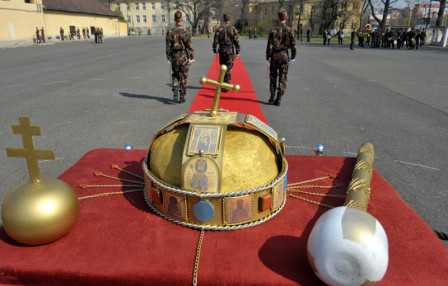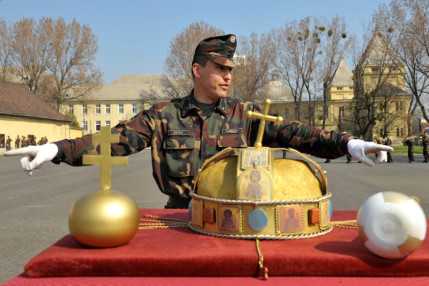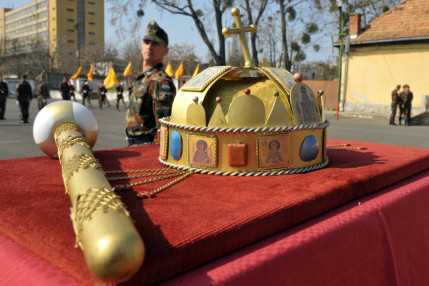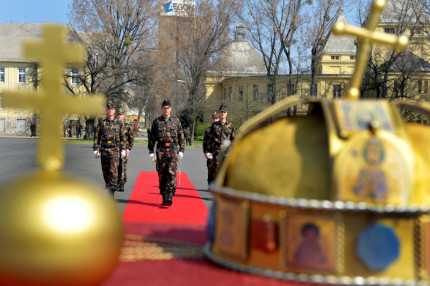He, the Holy Crown
Szöveg: György M. Tóth | 2011. április 4. 8:03‘He’. This is the ‘name’ candidate crown guards use to refer to the Holy Crown among themselves. The third person singular form expresses the greatest respect, which is due from the guardians who are going to assume their noble duty as of April 25. As a sign of respect, members of the first four detachments of candidate crown guards are preparing for their service on a demanding training program – as shown in our photos as well – and they are eager to learn indeed. On March 31, we paid a visit to the Petőfi barracks in Budapest to see how they progress with their ongoing training for honor guard and security duties “in the presence of the crown”.
The crown, the scepter and the orb – actually, the models of our national symbols in front of which a red carpet is laid and which are surrounded by the scale blueprint of the Dome Hall of Parliament building – belong to the designated commander of the Military Crown Guard. He received these gifts, made by the troops themselves, from the personnel of the HDF 86th Szolnok Helicopter Base when after 24 years of time in service, he said farewell to them and was given an entirely new task.
These farewell gifts have now become training aids. As we have learned from expert commentaries, the candidate crown guards were practicing drills with swords in use with the honor guard as well as slow parade steps in pairs within the security guard detachment, parade march and the protocol for the changing of the guard when their guard duty by the crown jewels is over. As part of the training, soldiers also went in for a test of stamina by standing at attention for the specified period with swords in their hands.
Talking of swords, it is worth mentioning that the service weapon of crown guards is the 1948-type Kossuth-sword, i.e. the standard cold steel in use with the HDF 32nd Budapest Parade Battalion. And as the professionals say, it takes a lot of patience and perseverance to learn how to stand at attention with a sword on baldric. Let us add that the formation drills and the applying regulations for guarding the crown jewels around the first decade of the 21st century will certainly be the subject of future historical research.
Until April 25 – the ceremonial takeover of the Holy Crown and the coronation regalia now on display in the Parliament building – the would-be crown guards still have a lot to learn. As part of their daily classroom program, during our visit Professor Endre Tóth, Head of Department, Hungarian National Museum was delivering a lecture on the methods for preserving the crown jewels in proper condition.
The training program in the formal drills to be executed around the crown, briefly described above, will be interrupted by a live fire exercise to be conducted in Püspökszilágy on April 1112 and a cohesion-enhancing training in Szolnok on April 1415. Examinations will be held on April 18, and following these, the development of skills for honor guard and security tasks is to continue on-site in the Parliament building.
(Click on our gallery for more pictures!)
Photo: Tünde Rácz







